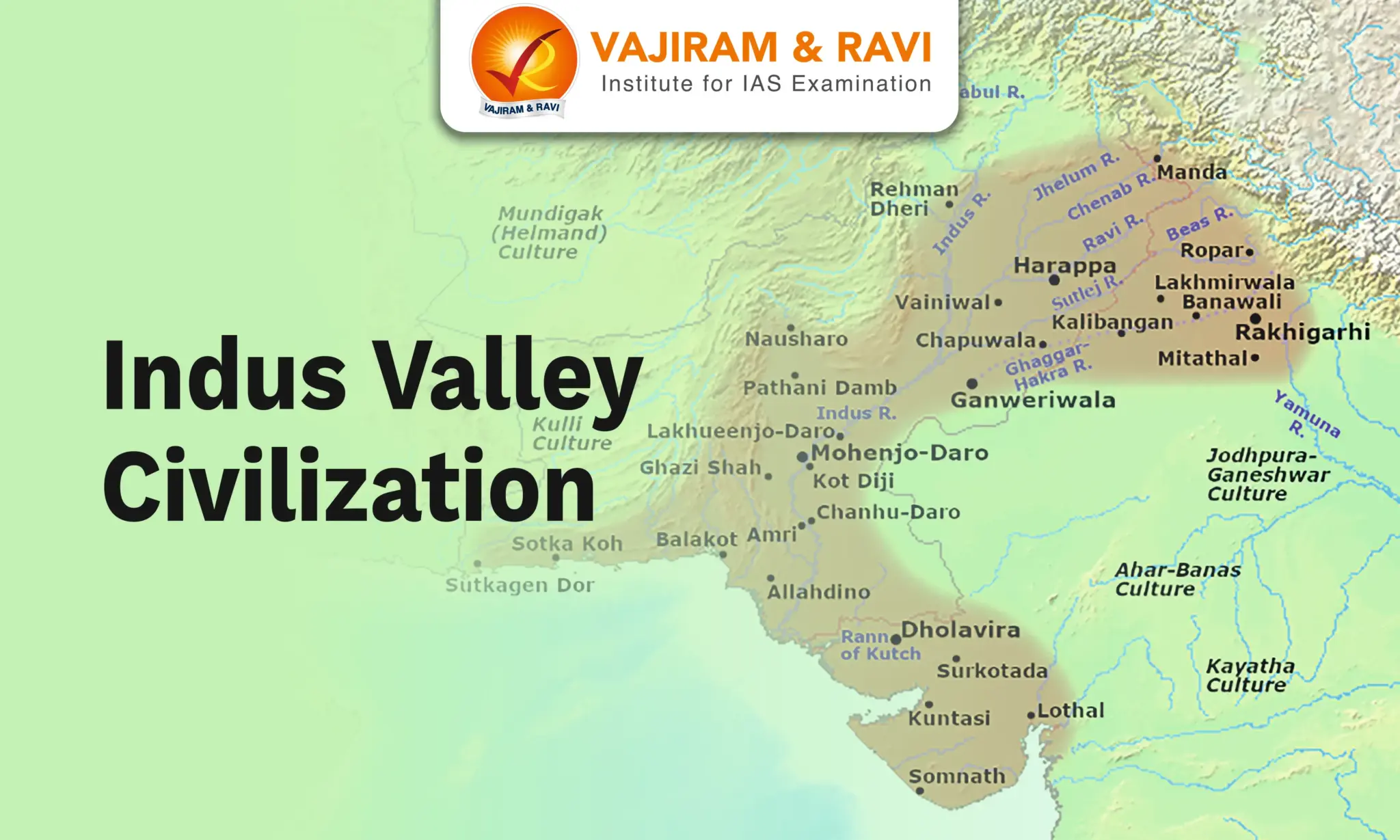Indus Valley civilization is the earliest known urban culture of the northwestern regions of the Indian subcontinent. It is one of the world’s three earliest civilizations along with Mesopotamia and ancient Egypt. This civilization flourished from approximately 3300 BCE to 1300 BCE. Geographical factors including soil fertility, climate, and physical features contributed to the development of the Indus Valley civilisation.
Most of the sites discovered earlier, Harappa and Mohenjo-Daro, are present in the Indus valley which gives the name to it. Later sites such as Kalibangan, Lothal, Rakhigarhi, etc revealed similar features. Harappa was the first excavated site therefore, it is also called Harappan culture.
Origin and Discovery of Indus Valley Civilization
The Indus civilization arose in the Indus River basin evolving from villages that followed the Mesopotamian model of irrigated agriculture.
- Origin: The Indus Valley in the Indian subcontinent was one of the first places where humans settled down and advanced to a highly civilised lifestyle.
- Its contemporary name comes from its location in the Indus River valley, but it is also known as the Indus-Sarasvati Civilization.
- Many sites were excavated later on the banks of the Ghaggar-Hakra river bed.
- Discovery of IVC: It was in 1924 that John Marshall announced to the world the existence of an ancient civilization in the Indus Valley.
- The first person to discover Harappa was Charles Masson, who identified it as an ancient city called Sangala from the time of Alexander.
- Excavating the ruins in the early twentieth century revealed their full significance. Daya Ram Sahni excavated Harappa in 1920, and Rakhaldas Banerjee excavated Mohenjo-daro in 1921.
- Geographical Factors: The geographical conditions in the Indus Valley must have been ideal for human settlement and development. Today, this terrain is extremely dry and unsuitable for human habitation.
- The Indus seals are found to have figures of a variety of plants and animals that can exist only in moderately wet conditions. Therefore, it is assumed that the climatic conditions were quite moderate.
- The vast plains along the Indus were very fertile. The floods deposited rich alluvial soil on these plains every year and irrigated the lands.
- Chronology: The civilization can be dated between 3300 BCE to 1300 BCE with the help of Radiocarbon dating. The entire timeline can be divided into three phases - Early Harappan, Mature Harappan and Late Harappan.
| Phases | Dates | Important Sites | Features |
| Early Harappan or Regionalization | 3300- 2600 BCE |
- Harappa - Kot Diji - Amri |
- Fortification and grid planning - Development of an incipient trade network - Craft specialisation. |
|
Transitional Phase
|
- Kunal - Dholavira - Harappa |
- Increasing level of craft specialization - Organised irrigation system - Partly standardised repertoire of pottery designs and forms. |
|
| Mature Harappan or Integration | 2600- 1800 BCE |
- Mohenjo-Daro - Harappa - Kalibangan - Dholavira |
- Full-scale urbanisation - Emergence of writing - Uniformity in artefacts - Full-fledged trade. |
| Late Harappan or Localization | Post 1800- 1500/1300 BCE |
- Cemetery H at Harappa - Siswal - Rojdi - Rangpur |
- Decline, and abandonment of some sites - Rise of pastoral mode. |
Map of Indus Valley Civilization
Indus sites are distributed across a large area in India and Pakistan. Geographically, the civilization extended outside the Indus zone. It was made up of riverine lowlands that spread east and southeast into Uttar Pradesh and Rajasthan, highlands and coastal parts in Balochistan, and a coastal strip in Gujarat.
- Area: It encompassed an area of approximately 1,299,600 square km.
- It covered a considerably broader region than the ancient Egyptian or Mesopotamian cultures did.
Sites of Indus Valley Civilization
The Indus Valley Civilization, situated in the river basins of the Indus and Ghaggar-Hakra, featured several key cities such as Mohenjo-Daro, Harappa, Kalibangan, Lothal, Rakhigarhi, Chanhudaro, Banawali, Dholavira, etc.
- It extended from Sutkagendor (in Balochistan, Pakistan) in the West to Alamgirpur (UP) in the East; and from Mandu (Jammu) in the North to Daimabad (Maharashtra) in the South.
| Major Indus Valley Sites | ||
| Major sites | Location (Present) | Major Findings |
|
Harappa (2600-1900 BCE) |
Punjab province of Pakistan (Ravi River) |
- The site was discovered by Daya Ram Sahni in 1920 - The city was divided into two parts, i.e., the citadel and the lower town. - Great Granary located in the citadel - Elaborate drainage facilities made of baked bricks. - Evidence of wheel-made and baked pottery. - Evidence of coffin burial. |
|
Mohenjo-Daro (2500-1700 BCE) |
Sindh Province, Pakistan (Indus River) |
- Included as a UNESCO World Heritage Site. - Mohenjo-Daro was divided into two parts: the Citadel and the Lower Town. - Great Bath ( ritual bathing site) and Great Granary. - Stone Art: Sculpture of Bearded Man - Bronze “Dancing Girl” Statue - Terracotta: Representations of bulls and buffalo and female figurines. - Complete burial - Seals: Depict animals, human figures, and even deities. Example: Pashupati seal. |
| Rakhigarhi | Hisar district, Haryana (Sarasvati River) |
- DNA analysis of Skeletal revealed that the Harappan civilization inhabitants had a distinct origin. - Land townships were enclosed with mud and burnt brick homes. - Efficient drainage system and proper sanitation. - The granary consisted of mud bricks and the floor was made of rammed earth plastered with mud. - A seal with an alligator symbol was discovered. |
|
Dholavira (3500-1800 BCE) |
Great Rann of Kutch, Gujarat |
- Included in the list of World Heritage Sites list of UNESCO in 2021. - Cities consisted of a citadel, a middle town, and a lower town. - Cascading series of water reservoirs, - Extensive use of stone in construction. - Special burial structures. - Black on red ware pottery, Redware, and Buff ware pottery. - It is renowned for its sophisticated water harvesting system and, therefore, known as alake city or a jala durga (water fort). |
|
Lothal (Mound of the dead) (2400-1600 BCE) |
Gulf of Khambhat region, Gujarat |
- A metropolis with an upper and a lower town. - A bead factory and tidal dockyard were discovered. - It is the only port town of the Indus Valley Civilization. - People worshipped the fire god. - Use ofcoffins inburial pits. - Redware and Blackware pottery. - Lothal has revealed the earliest evidence of rice cultivation in South Asia. |
|
Kalibangan (3500 BC-2500 BC) |
Rajasthan, (Ghaggar River) |
- It is made up of three mounds. - Known for its remarkable fire altars and the world's earliest attested ploughed field. - The earliest form of artificial irrigation was practised. - Different types of burials show social inequalities. - Mesopotamian pottery was discovered at the site, showing the trade relations. - Burnt bricks were used only for drains at Kalibangan. |
Features of IVC
The mature Harappan Phase includes a diverse range of urban and non-urban rural sites that vary in size and function but are inherently identifiable as Harappan settlements due to features such as town planning, pottery, script, seals, evidence of external trade, and so on. Some of these features have been discussed here.
Town Planning
One of the most outstanding features of the Indus cities was their well-planned town planning. The excavations at Harappa and Mohenjo-Daro have revealed a great deal of evidence of this.
- Two parts: Generally, the cities of Harappan culture had two parts - the citadel and the outer city.
- The citadel was erected on an elevated site. The outlying city was on a lower level.
- Grid patterns: The IVC cities were constructed in a grid arrangement, with streets flowing north-south and east-west, resulting in a well-organised structure.
- The roadways were large and straight, cutting each other at right angles.
- Drainage System: They had an excellent drainage system. The drains were built of mortar, lime, and gypsum. Each residence featured a sturdy washbasin from which water poured into the subsurface drains.
- Houses: Houses were of different types, small and large.
- Burnt bricks were extensively used to make houses and other structures.
- Houses were also provided with wells and bathrooms.
- Other important structures: The Great Bath and Pillared Hall at Mohenjo-Daro, the dockyard at Lothal, and the granary at Harappa.
Social Life
- Political authority: There may be some sort of political authority/State did exist in the Harappan civilization.
- The communications systems, standardisation of artifacts, site specialisation, use of a common system of writing, and the establishment of trading outposts like Shortughai are evidence of some kind of political authority.
- Social classes: The different types of houses indicate different social classes.
- Merchants appear to have formed the upper class as trading was the primary activity.
- The artisans and farmers might be the common people.
- Dress: The discovery of many spindles suggests the use of cotton and woollen fabrics.
- Ornaments: A large number of ornaments like necklaces, armlets, finger-rings, bangles, etc., have been found from these sites.
- These were made of gold, silver, ivory, and precious stones.
- Recreation and amusements: The people of Harappa appear to have enjoyed dance and music.
- They were also familiar with indoor activities such as dice.
- A great quantity of terracotta toys were discovered in Mohenjo-Daro.
Economic Conditions
The Harappan civilization occupied a varied landscape encompassing alluvial plains, mountains, plateaus, and sea coasts. The area was rich enough to generate a surplus which was crucial for urbanisation.
- Agriculture: Agriculture was the primary employment of the Indus Valley people. They cultivated wheat, barley, peas, and, in some places, rice.
- They produced enough for both themselves and trade.
- They did not irrigate their land with canals.
- The annual flood provided sufficient moisture to cultivate crops.
- Fields were ploughed using a wooden ploughshare.
- Domestication of animals: Based on the Indus seals, it can be said that many animals including goats, buffaloes, oxen, elephants, dogs, and camels were domesticated.
- However, the Harappans do not appear to have been familiar with the horse.
- Metallurgy: Harappans were aware of copper, gold, and silver metallurgy. Copper was widely used, and it occurs in the form of weapons, agricultural tools, ornaments, etc.
- Metalcasting appears to be a continuous tradition. The late Harappan and Chalcolithic sites like Daimabad in Maharashtra yielded excellent examples of metal-cast sculptures.
- Trade: The urban culture and highly specialised manufacturing activity indicate that Harappan cities enjoyed a thriving trade. There was flourishing internal trade between the cities.
- The river Indus served as the high waterway through which most of this trade was carried out.
- They also traded with Mesopotamian cities. Many Harappan seals have been found in Mesopotamian cities.
- They exported grain, jewellery, and pottery and imported thin copper and precious stones.
Religious Practices
One of the first understandings of the Harappan religion was forwarded by John Marshall. He found several parallels between the Harappan religion and modern Hinduism. One of the seals was identified by him as a ‘Proto-Shiva' seal.
- This seal has a male figure seated on a dais. His heels are joined, and his toes point downward. This position is very similar to mulabandhasana in yoga.
- Figurines resembling a female deity have been found. They suggest worship of the Mother Goddess
- No temples have been discovered at any of the Harappan sites.
- Harappans might have also venerated pipal trees. One seal depicts seven figures paying obeisance to the tree.
Art
- Art: Most human figurines were handmade and made from bronze, terracotta, steatite, and faience material.
- The female figures were embellished with ornate jewellery and headdresses. Example: Dancing girl Statue and priest-king (male figurine).
- Faience: It is an artificial material made from quartz. Several faience items, including beads, bangles, earrings, and figurines, have been discovered in Harappan archaeological sites.
- Crafts: The Harappan people were good craftsmen. They used more copper than bronze.
- Brick-making and masonry were other important occupations.
- Spinning and weaving too were a common craft.
- Pottery made on a potter's wheel was decorated with different designs and painted red and black.
- Script: The Indus seals are a unique source available to us to learn about the Harappan culture.
- They are small rectangular terracotta tablets with drawings of vegetation and animals. There is also visual text on them.
- Since this pictorial script has yet to be deciphered, our understanding of the Harappans is largely limited to those images.
- The Indus Script is boustrophedon (as an ox turns in ploughing). It is a term used for scripts that are written in both directions - left to right and right to left continuously.
Causes of Decline of Indus Valley Civilization
The Harappan Culture lasted for about a thousand years and collapsed by about 1300 BC. This coincides with the advent of the Aryans in India. The exact reason for the decline of this civilization is not known.
- Changes in Climatic conditions: The generally accepted view among historians is that a gradual change in climatic conditions rendered the region inhospitable and caused its decline.
- Natural Calamities: Some believe that natural calamities like floods or earthquakes might have caused its destruction.
- Decline in Trade: Extensive hydrological studies have established that the river Indus and Sarasvati changed their courses several times, maybe around 1900 BC.
- This calamity must have brought out large-scale changes or disruptions in the internal trade routes connecting the hinterland with the coast.
Indus Valley Civilization UPSC PYQs
Question 1: The ancient civilisation in the Indian sub-continent differed from those of Egypt, Mesopotamia, and Greece in that its culture and traditions have been preserved without a breakdown to the present day. Comment. (UPSC Mains 2015)
Question 2: To what extent has the urban planning and culture of the Indus Valley Civilization provided inputs to present-day urbanisation? Discuss. (UPSC Mains 2014)
Question 3: Which one of the following ancient towns is well-known for its elaborate system of water harvesting and management by building a series of dams and channelling water into connected reservoirs? (UPSC Prelims 2021)
- Dholavira
- Kalibangan
- Rakhigarhi
- Ropar
Answer (a)
Question 4: Which one of the following is not a Harappan site? (UPSC Prelims 2019)
- Chanhudaro
- Kot Diji
- Sohgaura
- Desalpur
Answer: (c)
Question 5: Which of the following characterise/characterises the people of the Indus Civilization? (UPSC Prelims 2013)
- They possessed great palaces and temples.
- They worshipped both male and female deities.
- They employed horse-drawn chariots in warfare.
Select the correct statements using the codes given below:
- 1 and 2 only
- 2 only
- 1, 2 and 3
- None of the above
Answer: (b)
| Other Related Posts | |
| Prehistoric Period | Indus Valley Civilization Sites |
| Chalcolithic Age | Rakhigarhi |
| Megalithic Culture | Lothal |
| Town Planning of Harappan Civilization | Kalibangan |
Last updated on November, 2025
→ Check out the latest UPSC Syllabus 2026 here.
→ Join Vajiram & Ravi’s Interview Guidance Programme for expert help to crack your final UPSC stage.
→ UPSC Mains Result 2025 is now out.
→ UPSC Notification 2026 is scheduled to be released on January 14, 2026.
→ UPSC Calendar 2026 is released on 15th May, 2025.
→ The UPSC Vacancy 2025 were released 1129, out of which 979 were for UPSC CSE and remaining 150 are for UPSC IFoS.
→ UPSC Prelims 2026 will be conducted on 24th May, 2026 & UPSC Mains 2026 will be conducted on 21st August 2026.
→ The UPSC Selection Process is of 3 stages-Prelims, Mains and Interview.
→ UPSC Result 2024 is released with latest UPSC Marksheet 2024. Check Now!
→ UPSC Prelims Result 2025 is out now for the CSE held on 25 May 2025.
→ UPSC Toppers List 2024 is released now. Shakti Dubey is UPSC AIR 1 2024 Topper.
→ UPSC Prelims Question Paper 2025 and Unofficial Prelims Answer Key 2025 are available now.
→ UPSC Mains Question Paper 2025 is out for Essay, GS 1, 2, 3 & GS 4.
→ UPSC Mains Indian Language Question Paper 2025 is now out.
→ UPSC Mains Optional Question Paper 2025 is now out.
→ Also check Best IAS Coaching in Delhi
Indus Valley Civilization FAQs
Q1. What is the period of Indus Valley Civilization?+
Q2. Why is the Indus Valley civilisation called Harappan civilisation?+
Q3. When was the Indus Valley civilisation discovered?+
Q4. What is Harappan Script?+
Q5. What are the features of Harappan seals?+

















